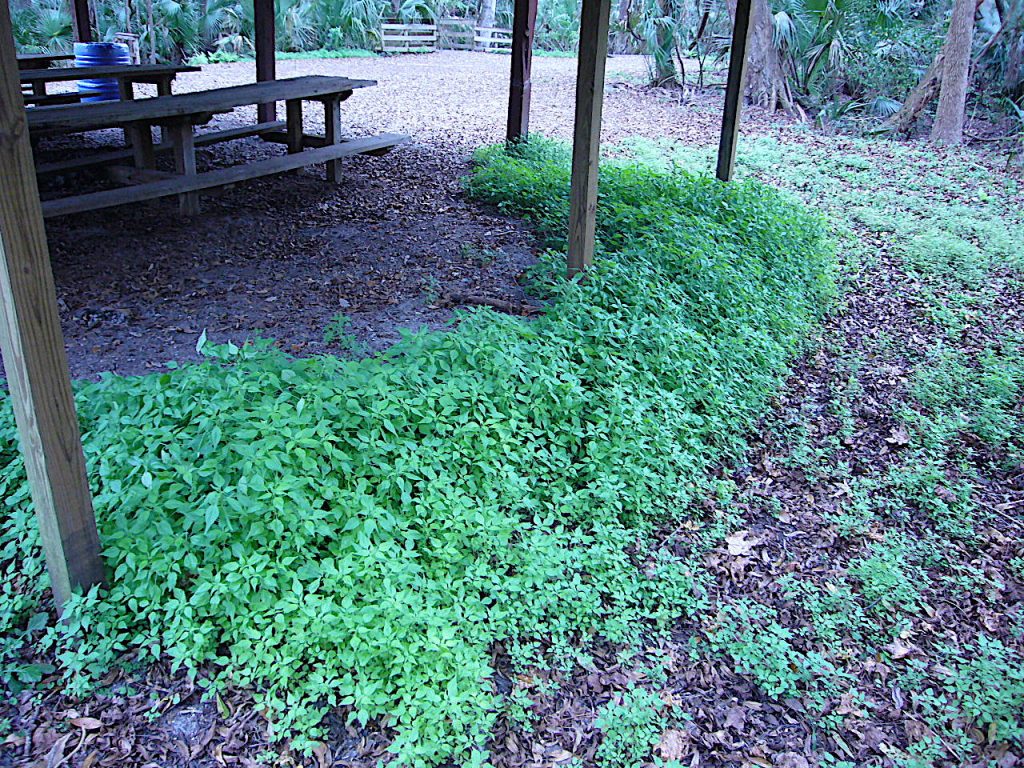
Pellitory likes cool weather and shade. Photo by Green Deane
Seasons can be subtle. Sometimes the weather shifts a little, a bit cooler or warmer in the morning, or more or less rain. To a forager it can be changes in plants. Are trees fruiting earlier or later? Are weeds showing up outside of season? That happened this week. During a foraging class near Daytona Beach we found Pellitory. It’s a common “winter time” edible here. One usually sees it around Thanksgiving with it disappearing around April Fool’s Day. In shade it can last longer into the spring and in some protected spots (under bridges) even into hot weather. But September is the earliest I’ve ever seen it. It was growing under a porch — not at all unusual — where it gets only early morning sun. The daytime highs have dropped about 10 degrees so perhaps that explains this early riser. You can read about Pellitory here.
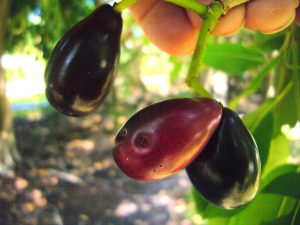
Even ripe Jambul fruit is slightly astringent. A little salt can make them taste better.
A significant number of invasive species were intentionally introduced by government agencies. Locally several come to mind from the smelly Skunk Vine (rope) to Brazilian Holly (a honey-producing ornamental.) One semi-tropical tree was introduced three times in Florida, the Jambul. We saw several this past weekend in fruit during a foraging class in West Palm Beach. It is also quite common to find them in Port Charlotte on the other coast. I know where one grows and fruits just north of Orlando. It was probably planted decades ago before the winter got cooler. Creating a large shade tree, three species of Jambuls are common: One produces a black fruit, another red fruit, and a third produces what we call “cloves” which is used as a spice. As nutritious as the fruit are, one problem is they are mildly astringent even when very ripe. You either have to like that, or, sprinkle salt on the fruit before eating. That helps reduce the astringency some. And while spring and summer are the reported ripening time of Jambuls locally — I have definitely harvested them in June — this is the last week in September. To read about the Jambul click here.
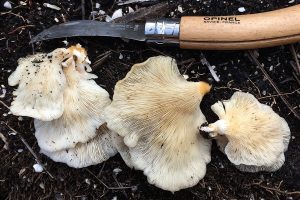
Many of the right characteristics did not add up to a solid identification.
I failed to identify a mushroom this week. That is not unusual. Mushrooms are detail and context heavy. What is usual is that you can do everything right and still not get a good identification. It’s not good enough to eliminate the “no” reasons. You also have to confirm the “yes” reasons. This mushroom looks like it might be an Oyster, which is a complex of edible mushrooms. There are at least three edible species of Oysters locally. These mushrooms are not large so that eliminated one (which also likes far cooler weather.) The shape knocked out another (that likes warm weather) and they are too large for the third. Zip. Zero. Zilch. Yet, it has the right color spore print, white to light lilac. That eliminates a toxic Oyster look-alike but still doesn’t make an identification. Also confusing things is that this flush was growing on a palm stump. Most Oysters prefer hardwoods. I could not find any references to them growing on palms. With mushrooms identifiers usually line up well. No questions left over. So these were photographs, spore printed, and distributed in the woods, not eaten.
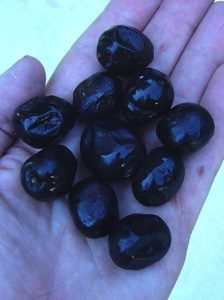
Eating Saw Palmetto fruit is a challenge.
One “revolting” encounter this week were some ripe Saw Palmetto berries. It is the season. I am not sure they are an “acquired” taste or a tolerated one. You will either be able to eat them or not. Basically they tastes like vomit. To be a little more gracious they taste like intense blue cheese with some burning hot pepper tossed in. Once you get used to them they are… endurable. But if you were hungry you would crave them in that they have all the amino acids humans need to be healthy. They are good for you even if you don’t like them (and of course they are medicinal.) As with some fruit — Durian for example — the smell is enough to dissuade many people from eating them. Saw Palmetto berries have been ripening for about a month.

Classes are held rain or shine or cold.
Heading north to Gainesville this Saturday for a foraging class. Then a class in Orlando Sunday. Also note in October there is a foraging class scheduled for Haulover Canal.
Saturday, September 29th, Boulware Springs Park, 3420 SE 15th St., Gainesville, FL 32641. 9 a.m. to noon. Meet at pavilion near pump house.
Sunday, September 30th, Blanchard Park, 10501 Jay Blanchard Trail, Orlando, Fl. 32817. 9 a.m. to noon. Meet at pavilion by the tennis courts by the YMCA building.
Saturday, October 6th, Eagle Lake Park, 1800 Keene Road, Largo, FL 33771. 9 to noon. Meet at the pavilion near the dog park, south end of the park.
Sunday, October 7th, Haulover Canal, Merritt Island National Refuge, north of the Kennedy Space Center. 9 to noon. Take SR 405 east from Titusville to SR 3, then turn left, or north. Haulover Canal is the only bridge you will cross on SR 3, approximately six miles. Go over the bridge, then turn left onto a dirt road, follow that to its western end. This class requires much walking, approximate four miles, and some embankment climbing.
Saturday, October 13th, Florida State College, south campus, 11901 Beach Blvd., Jacksonville, 32246. We will meet at building “D” next to the administration parking lot. 9 to noon
Sunday, October 14th, Wickham Park: 2500 Parkway Drive, Melbourne, FL 32935-2335. Meet at the “dog park” inside the park. Nine to noon.
To learn more about the classes go here.
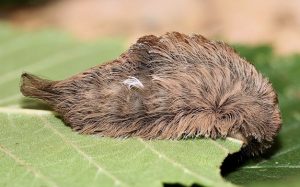
Puss Moth Caterpillar is a little fuzzy that stings badly.
As foragers we have learned to cope with bees, hornets, spiders, fire ants, redbug and poisonous snakes. We should add to that list hairy caterpillars. Not all hairy caterpillars are bad but enough are and worst of the lot in North America is the Asp Caterpillar, also called the Puss Moth Caterpillar. This fuzzy little wiggler has hairs with toxic connections. Even gently touching one can result in a painful envenomation that can create a burning pain, swelling, nausea, itching, abdominal distress, vomiting, and headache. These symptoms can last for days and travel, such has being stung on the hand but radiating up to the armpit. I did not find any death reports but there are occasional instances of numbness, vision problems, respiratory distress and shock. The pain has been likened to breaking an arm, being hit with a hammer and worse than kidney stones. Clearly difficult to ignore. The Asp Caterpillar likes the south, mainly Texas, Louisiana, Florida and North Carolina though Texas has more reports of encounters than all other states combined. Incidences have been reported as far north as Maryland and as far west as Arizona. Peak months for getting stung are July through November with October having the most cases. You’ve been warned. Also known as Megalopyge opercularis, it is considered one of the most toxic caterpillars in North America and is also found in Central and South America.
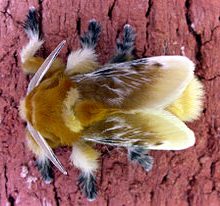
The Asp Caterpillar makes a fuzzy moth when it grows up.
One problem is that most health care professionals don’t recognize the signs and symptoms of the caterpillar’s envenomation, and who could expect them to? Home remedies for pain relief include using tape to pull off the stinging hairs (really spines) ice packs, oral antihistamines, baking soda on the site, hydrocortisone cream, juice of comfrey and calamine lotion. Medical literature suggests the pain can be treated with intravenous calcium gluconate or systemic corticosteroids. Unfortunately nothing seems to provide prompt relief. Avoidance of the creature is the best prevention. Look but don’t touch. I have been fortunate enough to see the caterpillar ahead of time or have it land on my clothes rather than on bare skin. And it does like trees so attack can come from above.

Green Deane DVD set of 135 videos
All of Green Deane’s videos are available for free on You Tube. They do have ads on them so every time you watch a Green Deane video I get a quarter of one cent. Four views, one cent. Not exactly a large money-maker but it helps pays for this newsletter. If you want to see the videos without ads and some in slightly better quality you can order the DVD set. It is nine DVDs with 15 videos on each for a total of 135 videos. Many people want their own copy of the videos or they have a slow service and its easier to order then to watch them on-line. The DVDs make a good gift for that forager you know especially on long, cold winter months. Individual DVDs can also be ordered or you can pick and choose. You can order them by clicking on the button on the top right hand side of this page (if your window is open wide enough.) Or you can go here.

Green Deane Forum
Want to identify a plant? Need to identify a plant? Looking for a foraging reference? Maybe you have a UFO, an Unidentified Flowering Object, you want identified. On the Green Deane Forum we — including Green Deane — chat about foraging all year. And it’s not just about warm-weather plants or just North American flora. Many nations share common weeds so there’s a lot to talk about. There’s also more than weeds. The reference section has information for foraging around the world. There are articles on food preservation, and forgotten skills from making bows to fermenting food. Recent topics include: I Finally Found Wapato, Looks like Corn, Weed With Pod At Top, A Mile Walk In The Woods, Chicken of the Woods?, Elderberry Fungus, Spurge Nettle 2018, Does Anybody Know This Berry, and Five-Minute “English” Muffin with Beautyberries. You can join the forum by clicking on the button in the menu line.
This is weekly issue 323.
If you would like to donate to Eat The Weeds please click here. Or you can use my Go Fund Me link, or by writing to Green Deane POB 941793 Maitland FL, 32794


Indeed seasons change .My country , Sudan , has witnessed extremely intensive rains this autum . People in my home town ,Kassala in eastern Sudan , are suffering from a disease called ” chugungaya” which causes severe fever accompanied with severe pain in joints resulting in total collapse and stagnation. Unfortunately recovery depends mainly on imunity and left to type of diet – both lacking in the community. We don’t complain of Puss fuzzy caterpillar ; in our case the cause is a mosquitoe borne virus.
I believe the specimen is indeed an oyster. Likely Pleurotus pulmonarius, commonly known as the phoenix oyster or Italian oyster. It has a tendency for hardwoods/deciduous softwoods but unlike most other oyster species it can be found/cultivated on conifers. Cool to find it on palm! They are typically smaller and whiter than ostreatus, but can get pretty big and still be a greyish-brown depending on environmental conditions. It might seem silly but a good way to ID oysters is by smell, oysters seem to have a rather distinct smell. But decurrent, tightly packed, blade-like gills are great indicators of an oyster. The specimen on the left is a good demonstration of the gills running down the stem to the base/attachment point. The lilac/white spore print is good confirmation as well. This time of year I would have usually thought ostreatus but the fact that it is florida and a palm tree I would say pulmonarius. The size and color also point to pulmonarius. All oysters that I am aware of are edible though. Its an easy mushroom to cultivate as well.